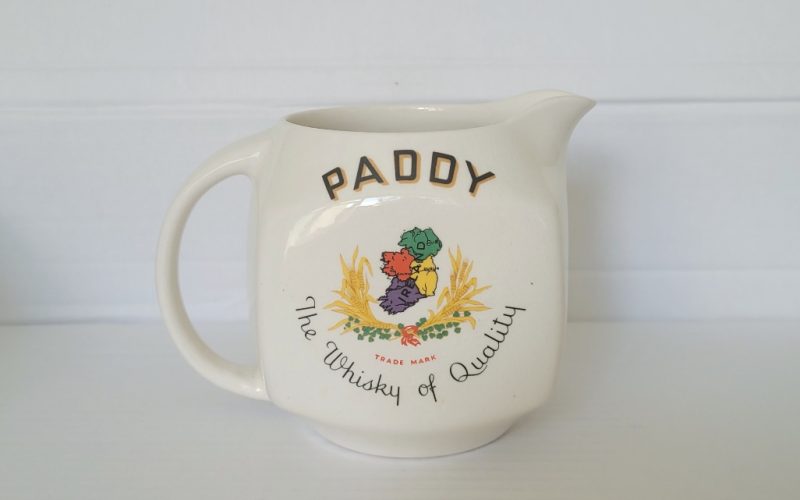Oscar Wilde once said that a cynic is “A man who knows the price of everything, and the value of nothing.” In many ways, this quote encapsulates the reason behind the creation of this website for Pub Jugs—a place to document, archive, and appreciate pub jugs made by Arklow Pottery in Co. Wicklow and Carrigaline Pottery in Co. Cork.
These jugs belong to a bygone era when the pub was a central part of Irish society, and their significance extends beyond their monetary worth.
Practical Use of Pub Jugs
Pub jugs were not merely decorative; they served a practical purpose. While true whiskey connoisseurs typically drink their whiskey neat or straight, most pub-goers preferred to mix it with something to mellow its intensity—most commonly, water. As a result, a jug of spring water was often left on the pub counter, allowing patrons to dilute their whiskey as desired.
Over time, these jugs became a focal point on bar counters, making their advertising potential apparent. Recognising this opportunity, brewers, distillers, and cigarette manufacturers commissioned ceramic producers such as Arklow and Carrigaline Pottery to create branded jugs. These jugs, adorned with company logos and advertisements, were then distributed to pubs as free promotional merchandise.
Whiskey, Water, and Irish Folklore
Whiskey and water share deep roots in Irish folklore. The Irish (Gaelic) word for whiskey is uisce beatha, meaning “water of life.” This term originates from uisce (“water”) and bethu (“life”), reflecting the cultural significance of whiskey in Ireland.
During the 1970s and 1980s, red lemonade also became a popular mixer for whiskey in Ireland. The Corcoran’s of Carlow jug, featured in our collection, might have once held red lemonade, sitting on a bar counter for customers to mix with their whiskey. Even today, some Irish pubs keep a large bottle of red lemonade (TK) on hand for patrons who prefer their whiskey with a splash of this distinctive soft drink, which is considered a part of Irish cultural identity.
Pug Jugs as Advertising Tools
Water pitchers have long been used for advertising, especially to promote sales of beer, wine, and spirits. These vessels, commonly referred to as “pub jugs,” gained popularity as early as the 1840s when distilleries began offering them to tavern owners as promotional items. While they were widespread across Europe, the use of whiskey water pitchers for advertising in the United States only gained traction after World War II.
Various materials have been used to craft these pub jugs, including china, glass, tin, enamelled metal, and aluminium. However, china or porcelain remains the preferred choice. Numerous manufacturers worldwide have produced these jugs, including Royal Doulton, Wade Regicor, Euroceramics, Seton Pottery, James Green & Nephew, Arklow Pottery, Carrigaline Pottery, Elischer, and Shelly.
Additionally, many prominent distilleries have designed their own unique jugs, which have become recognisable trademarks.
Collecting Pub Jugs
The collection of pub jugs became a popular hobby in the 1980s. Older jugs, particularly those in mint condition, are highly sought after by collectors. The value of a jug is determined by factors such as visual appeal, rarity, and condition. As vintage jugs become scarcer, the demand for newer ones has increased, along with their value.
Whisky water pitchers can be found in antique shops, auctions, flea markets, and yard sales, catering to collectors with varying budgets, with prices ranging from a few Euros to thousands.
One of the world’s biggest collectors of pub jugs is Orzes Alessandro, who runs the site WhiskyJugs and has a collection of approximately 4,000 jugs.
